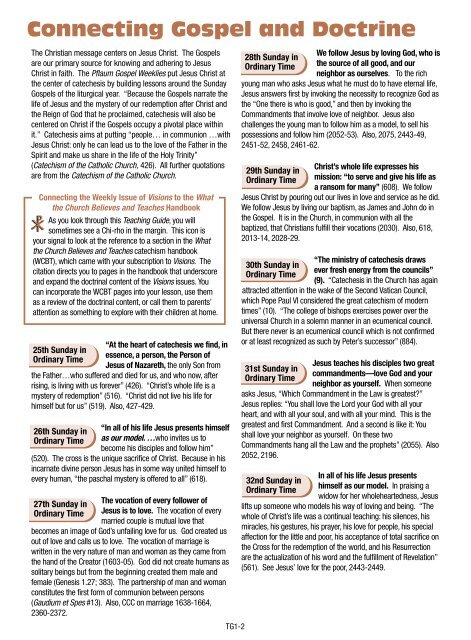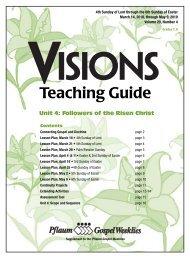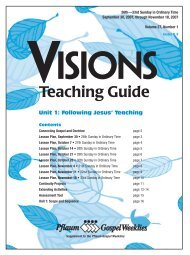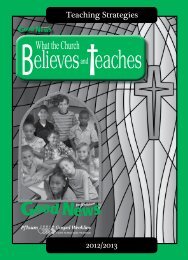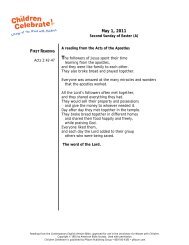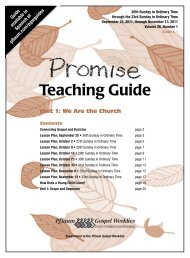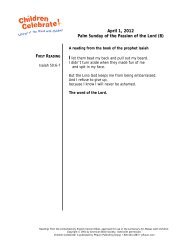Visions - Pflaum Home
Visions - Pflaum Home
Visions - Pflaum Home
You also want an ePaper? Increase the reach of your titles
YUMPU automatically turns print PDFs into web optimized ePapers that Google loves.
Connecting Gospel and Doctrine<br />
The Christian message centers on Jesus Christ. The Gospels<br />
are our primary source for knowing and adhering to Jesus<br />
Christ in faith. The <strong>Pflaum</strong> Gospel Weeklies put Jesus Christ at<br />
the center of catechesis by building lessons around the Sunday<br />
Gospels of the liturgical year. “Because the Gospels narrate the<br />
life of Jesus and the mystery of our redemption after Christ and<br />
the Reign of God that he proclaimed, catechesis will also be<br />
centered on Christ if the Gospels occupy a pivotal place within<br />
it.” Catechesis aims at putting “people… in communion …with<br />
Jesus Christ: only he can lead us to the love of the Father in the<br />
Spirit and make us share in the life of the Holy Trinity”<br />
(Catechism of the Catholic Church, 426). All further quotations<br />
are from the Catechism of the Catholic Church.<br />
Connecting the Weekly Issue of <strong>Visions</strong> to the What<br />
the Church Believes and Teaches Handbook<br />
As you look through this Teaching Guide, you will<br />
sometimes see a Chi-rho in the margin. This icon is<br />
your signal to look at the reference to a section in the What<br />
the Church Believes and Teaches catechism handbook<br />
(WCBT), which came with your subscription to <strong>Visions</strong>. The<br />
citation directs you to pages in the handbook that underscore<br />
and expand the doctrinal content of the <strong>Visions</strong> issues. You<br />
can incorporate the WCBT pages into your lesson, use them<br />
as a review of the doctrinal content, or call them to parents’<br />
attention as something to explore with their children at home.<br />
25th Sunday in<br />
Ordinary Time<br />
“At the heart of catechesis we find, in<br />
essence, a person, the Person of<br />
Jesus of Nazareth, the only Son from<br />
the Father…who suffered and died for us, and who now, after<br />
rising, is living with us forever” (426). “Christ’s whole life is a<br />
mystery of redemption” (516). “Christ did not live his life for<br />
himself but for us” (519). Also, 427-429.<br />
26th Sunday in<br />
Ordinary Time<br />
“In all of his life Jesus presents himself<br />
as our model. …who invites us to<br />
become his disciples and follow him”<br />
(520). The cross is the unique sacrifice of Christ. Because in his<br />
incarnate divine person Jesus has in some way united himself to<br />
every human, “the paschal mystery is offered to all” (618).<br />
27th Sunday in<br />
Ordinary Time<br />
The vocation of every follower of<br />
Jesus is to love. The vocation of every<br />
married couple is mutual love that<br />
becomes an image of God’s unfailing love for us. God created us<br />
out of love and calls us to love. The vocation of marriage is<br />
written in the very nature of man and woman as they came from<br />
the hand of the Creator (1603-05). God did not create humans as<br />
solitary beings but from the beginning created them male and<br />
female (Genesis 1.27; 383). The partnership of man and woman<br />
constitutes the first form of communion between persons<br />
(Gaudium et Spes #13). Also, CCC on marriage 1638-1664,<br />
2360-2372.<br />
TG1-2<br />
28th Sunday in<br />
Ordinary Time<br />
We follow Jesus by loving God, who is<br />
the source of all good, and our<br />
neighbor as ourselves. To the rich<br />
young man who asks Jesus what he must do to have eternal life,<br />
Jesus answers first by invoking the necessity to recognize God as<br />
the “One there is who is good,” and then by invoking the<br />
Commandments that involve love of neighbor. Jesus also<br />
challenges the young man to follow him as a model, to sell his<br />
possessions and follow him (2052-53). Also, 2075, 2443-49,<br />
2451-52, 2458, 2461-62.<br />
29th Sunday in<br />
Ordinary Time<br />
Christ’s whole life expresses his<br />
mission: “to serve and give his life as<br />
a ransom for many” (608). We follow<br />
Jesus Christ by pouring out our lives in love and service as he did.<br />
We follow Jesus by living our baptism, as James and John do in<br />
the Gospel. It is in the Church, in communion with all the<br />
baptized, that Christians fulfill their vocations (2030). Also, 618,<br />
2013-14, 2028-29.<br />
30th Sunday in<br />
Ordinary Time<br />
“The ministry of catechesis draws<br />
ever fresh energy from the councils”<br />
(9). “Catechesis in the Church has again<br />
attracted attention in the wake of the Second Vatican Council,<br />
which Pope Paul VI considered the great catechism of modern<br />
times” (10). “The college of bishops exercises power over the<br />
universal Church in a solemn manner in an ecumenical council.<br />
But there never is an ecumenical council which is not confirmed<br />
or at least recognized as such by Peter’s successor” (884).<br />
31st Sunday in<br />
Ordinary Time<br />
Jesus teaches his disciples two great<br />
commandments—love God and your<br />
neighbor as yourself. When someone<br />
asks Jesus, “Which Commandment in the Law is greatest?”<br />
Jesus replies: “You shall love the Lord your God with all your<br />
heart, and with all your soul, and with all your mind. This is the<br />
greatest and first Commandment. And a second is like it: You<br />
shall love your neighbor as yourself. On these two<br />
Commandments hang all the Law and the prophets” (2055). Also<br />
2052, 2196.<br />
32nd Sunday in<br />
Ordinary Time<br />
In all of his life Jesus presents<br />
himself as our model. In praising a<br />
widow for her wholeheartedness, Jesus<br />
lifts up someone who models his way of loving and being. “The<br />
whole of Christ’s life was a continual teaching: his silences, his<br />
miracles, his gestures, his prayer, his love for people, his special<br />
affection for the little and poor, his acceptance of total sacrifice on<br />
the Cross for the redemption of the world, and his Resurrection<br />
are the actualization of his word and the fulfillment of Revelation”<br />
(561). See Jesus’ love for the poor, 2443-2449.


